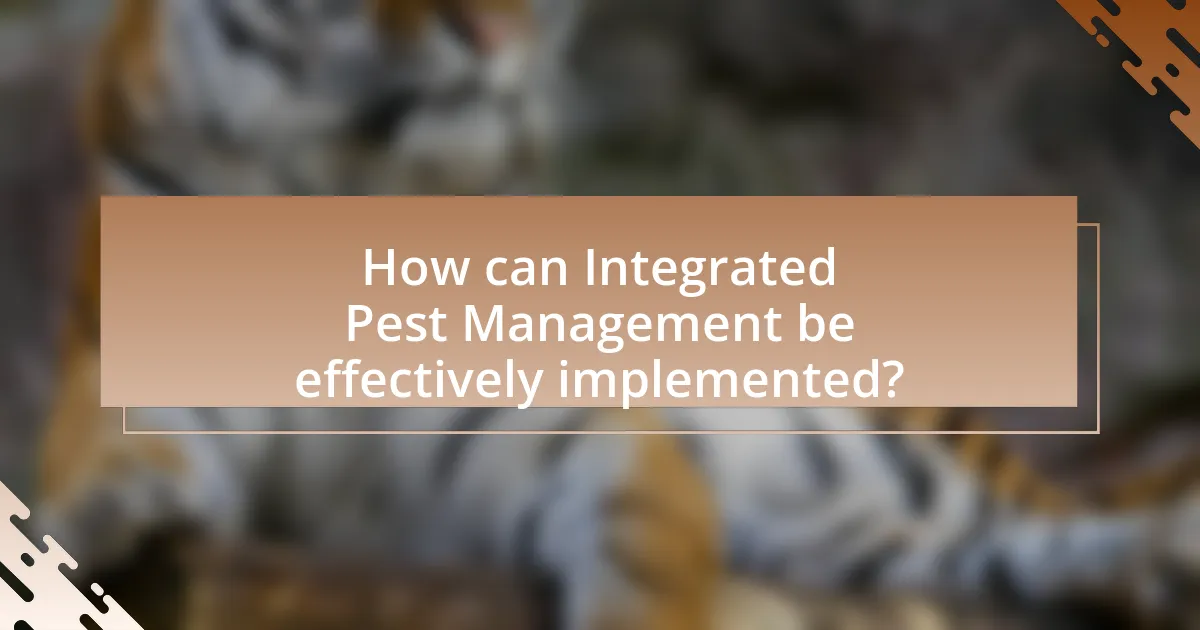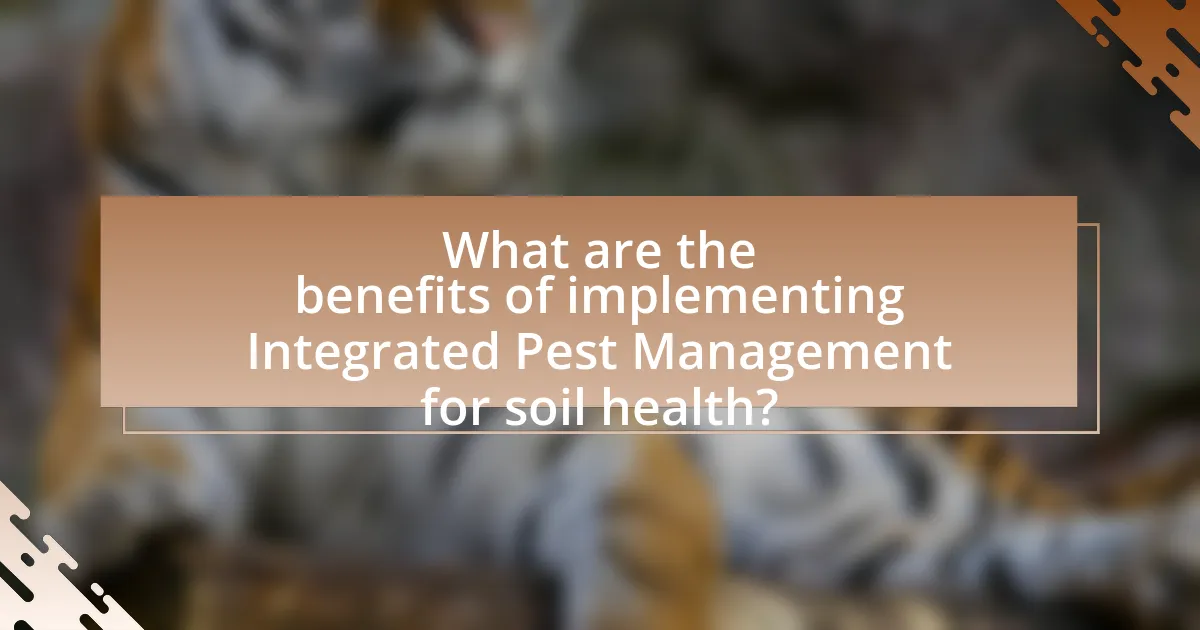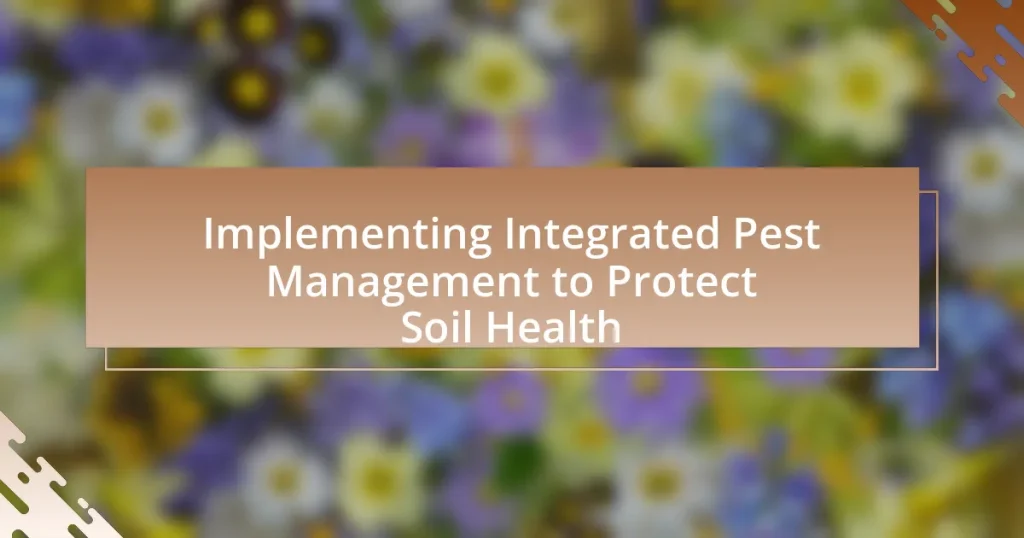Integrated Pest Management (IPM) is a sustainable pest control strategy that integrates biological, cultural, physical, and chemical methods to minimize risks to health, economy, and the environment while protecting soil health. This article explores the differences between IPM and traditional pest control, emphasizing the importance of soil health in pest management and the environmental impacts of pests on soil ecosystems. Key principles of IPM, effective implementation strategies, and the benefits of IPM for enhancing soil health and promoting sustainable agriculture are discussed, along with challenges and misconceptions surrounding its adoption. Additionally, the article outlines best practices and resources available for farmers to improve their IPM strategies.

What is Integrated Pest Management and its role in protecting soil health?
Integrated Pest Management (IPM) is a sustainable approach to managing pests that combines biological, cultural, physical, and chemical tools in a way that minimizes economic, health, and environmental risks. IPM plays a crucial role in protecting soil health by promoting practices that enhance soil structure, fertility, and biodiversity while reducing reliance on chemical pesticides that can degrade soil quality. For instance, studies have shown that IPM practices, such as crop rotation and the use of beneficial organisms, can improve soil organic matter and microbial activity, which are essential for maintaining healthy soil ecosystems.
How does Integrated Pest Management differ from traditional pest control methods?
Integrated Pest Management (IPM) differs from traditional pest control methods by emphasizing a holistic approach that integrates multiple strategies for pest management rather than relying solely on chemical pesticides. IPM focuses on understanding pest life cycles, monitoring pest populations, and using a combination of biological, cultural, physical, and chemical controls to minimize pest damage while reducing environmental impact. For example, a study published in the Journal of Integrated Pest Management highlights that IPM can reduce pesticide use by 50% or more compared to conventional methods, demonstrating its effectiveness in promoting sustainable agriculture and protecting soil health.
What are the key principles of Integrated Pest Management?
The key principles of Integrated Pest Management (IPM) include the integration of biological, cultural, physical, and chemical tools to manage pest populations in an environmentally and economically sustainable manner. IPM emphasizes the importance of monitoring pest populations and their natural enemies, setting action thresholds, and employing a combination of management strategies to minimize risks to human health and the environment. Research indicates that IPM can reduce pesticide use by 50% or more while maintaining crop yields, demonstrating its effectiveness in sustainable agriculture practices.
Why is soil health important in the context of pest management?
Soil health is crucial in pest management because healthy soil promotes biodiversity, which can naturally suppress pest populations. Healthy soils support a diverse community of microorganisms and beneficial insects that contribute to pest control by preying on harmful pests or competing with them for resources. Research indicates that farms with higher soil organic matter and microbial diversity experience lower pest pressures, as seen in studies conducted by the USDA, which found that improved soil health can lead to a 30% reduction in pest incidence. Thus, maintaining soil health is a key strategy in effective pest management.
What are the environmental impacts of pests on soil health?
Pests negatively impact soil health by disrupting soil structure, reducing nutrient availability, and harming beneficial microorganisms. For instance, certain pests, such as root-feeding nematodes, can damage plant roots, leading to decreased plant growth and reduced organic matter input into the soil. This disruption can result in lower soil fertility and diminished microbial activity, which are crucial for nutrient cycling. Research indicates that pest infestations can lead to a decline in soil organic carbon levels, further exacerbating soil degradation. Therefore, managing pests effectively is essential for maintaining healthy soil ecosystems.
How do pests affect soil structure and fertility?
Pests negatively impact soil structure and fertility by disrupting the balance of soil organisms and degrading organic matter. For instance, certain pests, such as root-feeding nematodes, can damage plant roots, leading to reduced plant growth and lower organic matter input into the soil. This degradation can result in compaction and reduced porosity, which impairs water infiltration and aeration. Additionally, pests can alter the microbial community in the soil, leading to a decline in beneficial microorganisms that contribute to nutrient cycling and soil health. Research indicates that pest infestations can lead to a significant decrease in soil fertility, as evidenced by studies showing that fields with high pest populations often exhibit lower nutrient levels and poorer soil structure compared to pest-managed fields.
What role do pests play in soil microbial communities?
Pests play a significant role in soil microbial communities by influencing microbial diversity and activity. The presence of pests can alter the composition of microbial populations, as they may introduce organic matter through their waste and decaying bodies, which serves as a nutrient source for soil microbes. Research indicates that pest-induced changes can enhance microbial biomass and activity, thereby affecting nutrient cycling and soil health. For instance, studies have shown that pest interactions can lead to increased microbial diversity, which is crucial for maintaining ecosystem resilience and functionality.

How can Integrated Pest Management be effectively implemented?
Integrated Pest Management (IPM) can be effectively implemented by integrating multiple control strategies that focus on long-term prevention and management of pest populations. This approach includes monitoring pest populations, identifying pest species, and assessing the potential impact of pests on crops.
Effective implementation involves using a combination of biological control methods, cultural practices, mechanical controls, and, when necessary, chemical controls, ensuring that pesticides are used judiciously and only as a last resort. Research indicates that farms employing IPM practices can reduce pesticide use by 50% while maintaining crop yields, demonstrating the effectiveness of this approach in sustainable agriculture.
What steps are involved in developing an Integrated Pest Management plan?
The steps involved in developing an Integrated Pest Management (IPM) plan include assessing the pest situation, setting action thresholds, monitoring and identifying pests, implementing control measures, and evaluating the effectiveness of the management strategies.
First, assessing the pest situation involves understanding the types of pests present and their population levels. Next, setting action thresholds determines the level of pest populations that require management to prevent unacceptable damage. Monitoring and identifying pests is crucial for accurate pest identification and population assessment. Implementing control measures involves using a combination of biological, cultural, physical, and chemical methods tailored to the specific pest problem. Finally, evaluating the effectiveness of the management strategies ensures that the IPM plan is working as intended and allows for adjustments as necessary.
These steps are essential for creating a comprehensive IPM plan that effectively protects soil health while minimizing environmental impact.
How do you assess pest populations and their impact on soil health?
To assess pest populations and their impact on soil health, one must conduct regular monitoring of pest species through methods such as visual inspections, traps, and soil sampling. These assessments help identify pest density and diversity, which are critical for understanding their effects on soil organisms and nutrient cycling. Research indicates that high pest populations can disrupt soil microbial communities, leading to decreased soil fertility and health. For instance, studies have shown that certain pests can reduce beneficial microbial activity by up to 50%, negatively affecting soil structure and nutrient availability. Therefore, consistent evaluation of pest populations is essential for implementing effective Integrated Pest Management strategies that protect soil health.
What monitoring techniques are essential for Integrated Pest Management?
Essential monitoring techniques for Integrated Pest Management (IPM) include visual inspections, trap monitoring, and the use of pest forecasting models. Visual inspections involve regularly checking plants for signs of pest damage or presence, allowing for early detection and intervention. Trap monitoring utilizes various traps to capture and identify pest populations, providing quantitative data on pest levels. Pest forecasting models analyze environmental conditions and pest life cycles to predict pest outbreaks, enabling proactive management strategies. These techniques are validated by research indicating that timely monitoring significantly reduces pest populations and minimizes crop damage, thereby supporting sustainable agricultural practices.
What strategies can be employed in Integrated Pest Management?
Integrated Pest Management (IPM) employs several strategies to effectively control pest populations while minimizing environmental impact. These strategies include biological control, which utilizes natural predators or parasites to manage pests; cultural practices, such as crop rotation and proper sanitation, to disrupt pest life cycles; mechanical control, involving physical barriers or traps; and the judicious use of chemical control, applying pesticides only when necessary and in targeted ways. Research indicates that IPM can reduce pesticide use by 50% or more while maintaining crop yields, demonstrating its effectiveness in sustainable agriculture.
How can cultural practices enhance soil health while managing pests?
Cultural practices enhance soil health while managing pests by promoting biodiversity, improving soil structure, and reducing pest populations through non-chemical means. For instance, crop rotation disrupts pest life cycles and enhances soil nutrient availability, as different crops contribute varying organic matter and nutrient profiles to the soil. Additionally, practices such as cover cropping prevent soil erosion and improve soil organic matter, which supports beneficial microorganisms that can outcompete or suppress harmful pests. Research indicates that integrated approaches, including these cultural practices, can lead to a 30% reduction in pest populations while simultaneously improving soil health metrics, such as increased organic carbon levels and enhanced microbial diversity.
What biological control methods are effective in Integrated Pest Management?
Effective biological control methods in Integrated Pest Management (IPM) include the use of natural predators, parasitoids, and pathogens to manage pest populations. For instance, introducing ladybugs can effectively control aphid populations, while parasitic wasps can target caterpillar pests. Additionally, the application of beneficial nematodes can help control soil-dwelling pests like grubs. Research indicates that these methods not only reduce reliance on chemical pesticides but also promote biodiversity and enhance soil health, as evidenced by studies showing improved soil microbial activity in fields utilizing biological controls.

What are the benefits of implementing Integrated Pest Management for soil health?
Implementing Integrated Pest Management (IPM) enhances soil health by promoting biodiversity, reducing chemical inputs, and improving soil structure. Biodiversity is increased through the use of beneficial organisms that naturally control pests, which helps maintain a balanced ecosystem. Reduced chemical inputs minimize soil contamination and preserve microbial communities essential for nutrient cycling. Improved soil structure results from practices like crop rotation and cover cropping, which enhance soil aeration and water retention. Research indicates that farms utilizing IPM practices show higher soil organic matter levels, contributing to overall soil fertility and resilience.
How does Integrated Pest Management contribute to sustainable agriculture?
Integrated Pest Management (IPM) contributes to sustainable agriculture by promoting ecological balance and reducing reliance on chemical pesticides. IPM employs a combination of biological, cultural, physical, and chemical tools to manage pest populations in an environmentally sound manner. For instance, studies have shown that farms utilizing IPM practices can reduce pesticide use by 50% or more while maintaining crop yields, thereby minimizing chemical runoff and protecting soil health. This approach not only enhances biodiversity but also supports the long-term viability of agricultural systems by fostering resilience against pest outbreaks and reducing the risk of pest resistance.
What economic advantages does Integrated Pest Management offer to farmers?
Integrated Pest Management (IPM) offers significant economic advantages to farmers by reducing pest-related crop losses and minimizing input costs. By employing a combination of biological, cultural, and chemical control methods, farmers can effectively manage pest populations while decreasing reliance on expensive chemical pesticides. Research indicates that IPM can lead to a 10-30% increase in crop yields due to improved pest control, which directly translates to higher profits. Additionally, IPM practices often result in lower costs for pest management, as they promote the use of natural pest predators and sustainable practices, reducing the need for costly chemical interventions. This dual benefit of increased yields and reduced costs enhances overall farm profitability.
How does Integrated Pest Management improve biodiversity in agricultural systems?
Integrated Pest Management (IPM) improves biodiversity in agricultural systems by promoting a balanced ecosystem that supports a variety of organisms. IPM practices, such as crop rotation, intercropping, and the use of natural predators, reduce reliance on chemical pesticides, which can harm non-target species and disrupt ecological balance. Research indicates that farms employing IPM strategies can experience increased populations of beneficial insects and soil microorganisms, leading to enhanced pollination and nutrient cycling. For instance, a study published in the journal “Agriculture, Ecosystems & Environment” found that IPM practices can increase the abundance of beneficial arthropods by up to 50%, thereby fostering greater biodiversity and resilience in agricultural landscapes.
What challenges might arise when implementing Integrated Pest Management?
Implementing Integrated Pest Management (IPM) can face several challenges, including the need for extensive knowledge and training among practitioners. Effective IPM requires understanding pest biology, ecology, and the interactions between various control methods, which can be complex and time-consuming to master. Additionally, farmers may encounter resistance from pests to certain management strategies, necessitating ongoing adaptation and innovation. Economic constraints can also pose a challenge, as initial costs for implementing IPM practices may be higher than traditional methods, potentially discouraging adoption. Furthermore, the integration of multiple control strategies can lead to logistical difficulties in planning and execution, particularly in large-scale agricultural operations. These challenges highlight the necessity for education, resources, and support systems to facilitate successful IPM implementation.
How can farmers overcome resistance to Integrated Pest Management practices?
Farmers can overcome resistance to Integrated Pest Management (IPM) practices by providing education and training on the benefits and effectiveness of IPM. Research shows that when farmers understand the economic and environmental advantages of IPM, such as reduced pesticide costs and improved crop yields, they are more likely to adopt these practices. For instance, a study published in the Journal of Integrated Pest Management found that educational programs increased IPM adoption rates by 30% among participating farmers. Additionally, farmers can collaborate with agricultural extension services to receive ongoing support and resources, which further facilitates the transition to IPM methods.
What are common misconceptions about Integrated Pest Management?
Common misconceptions about Integrated Pest Management (IPM) include the belief that it solely relies on chemical pesticides, that it is ineffective compared to conventional methods, and that it is too complex for practical application. In reality, IPM emphasizes a holistic approach that integrates various strategies, including biological control, habitat manipulation, and cultural practices, alongside judicious pesticide use when necessary. Research shows that IPM can reduce pest populations effectively while minimizing environmental impact, as demonstrated in studies like “The Role of Integrated Pest Management in Sustainable Agriculture” published in the Journal of Agricultural and Environmental Ethics, which highlights its effectiveness in promoting sustainable practices.
What best practices should be followed for successful Integrated Pest Management?
Successful Integrated Pest Management (IPM) requires a combination of strategies, including monitoring pest populations, using resistant plant varieties, and implementing cultural practices. Monitoring involves regularly assessing pest levels to make informed decisions about control measures, which can reduce unnecessary pesticide use. Utilizing resistant plant varieties minimizes the likelihood of pest infestations, while cultural practices such as crop rotation and proper sanitation disrupt pest life cycles and reduce their populations. Research indicates that these practices collectively enhance soil health by promoting biodiversity and reducing chemical inputs, ultimately leading to more sustainable agricultural systems.
How can farmers continuously improve their Integrated Pest Management strategies?
Farmers can continuously improve their Integrated Pest Management (IPM) strategies by regularly monitoring pest populations and employing adaptive management techniques. This involves using data from pest monitoring to make informed decisions about pest control methods, which can include biological controls, cultural practices, and targeted chemical applications. Research indicates that farmers who implement regular scouting and data analysis can reduce pest damage by up to 30%, leading to more effective and sustainable pest management. Additionally, participating in training programs and collaborating with agricultural extension services can provide farmers with the latest IPM practices and innovations, further enhancing their strategies.
What resources are available for farmers to learn about Integrated Pest Management?
Farmers can access various resources to learn about Integrated Pest Management (IPM), including university extension programs, government agricultural agencies, and online platforms. University extension services often provide workshops, publications, and expert consultations tailored to local agricultural conditions. For example, the USDA’s National Institute of Food and Agriculture offers educational materials and funding for IPM initiatives. Additionally, the Environmental Protection Agency (EPA) provides guidelines and resources on IPM practices. Online platforms like eXtension and the IPM Institute of North America also offer comprehensive information, including best practices and case studies, to support farmers in implementing effective IPM strategies.










